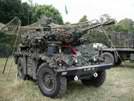
|
Alvis/ROF CVR(W) Fox. 1970s recce vehicle used mainly by TA Cavalry units. The Fox is a development of the late-production Ferret. It is powered by Jaguar J60 4.2l petrol engine. Armed with 30mm Rarden Cannon and 2 x 7.62mm GPMGs it weighs about 6 tonnes with crew of 3. It can ford up to 1 metre and can swim with a flotation screen erected. It is also air-transportable; 3 Foxes fit in a Lockheed C-130 Hercules which has to land to deploy them, or 2 if they are paradropped. It has an aluminum hull and turret, so is fast and fun, but prone to falling over! (Sadly we've now sold the Fox, so it is no longer available).
|
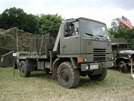
|
Bedford TM 4-4. 8 tonne flatbed 4 wheel drive truck with 3.5t Atlas crane. Powered by 220hp Bedford 8.2l turbo diesel. It was developed first in answer to a British Army requirement issued during the early 1970s, but the first production examples were not delivered until 1981. It was a fuel capacity of 155 litres and a maximum load of 8000 kg. Recently aquired to carry our mass of equipment. Unfortunately what used to fit in a 101 and trailer seems to have expanded to fill the Bedford!
|
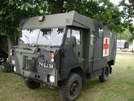
|
Land Rover 1 tonne Ambulance. The Landrover One Tonne Forward Control (101) was originally developed to tow the 105mm light gun in the early 70s. 2669 were built in 1976-78 mainly for the MOD but some were bought by other nations. The main variant was the GS with winch and were used as gun tractors and Rapier Missile tractors. Others were bodied as ambulances and there were two types of radio-bodied vehicles. They are fitted with 3.5l V8 petrol engine and 4F 1R x 2 permanent four wheel drive. Top speed for the brave or foolhardy is reputed to be79mph but the brakes leave a lot to be desired. Fuel consumption loaded is 9 - 12mpg! This is a One Tonne ambulance variant equipped with 4 stretchers. Our example is fully kitted out. It has recently been replaced in service by Landrover 130 XD "Pulse" Battlefield Ambulance.
|

|
Land Rover 1 tonne GS. We have 2 that make regular appearances. The one shown is an ex RAF Rapier tractor from RAF Brize Norton. It sat at Ashchurch Depot as a chassis cab until 1980 when it was converted to 24V, had a winch fitted and bodied as a Rapier tractor. Used to tow our loaned Rapier missile launcher. Our other example is a 12V gun tractor. It served with 201 Battery (The Hertfordshire and Bedfordshire Yeomanry) 100 Regt. RA(V) and has been restored to service condition. Unfortunately we don't yet have a 105mm Light Gun (any offers?). The One Tonne GS has been replaced in service by the Steyr Puch Pinzgauer.
|
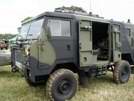
|
Land Rover 1 tonne 24V FFR Radio Body. This immaculate example is fully fitted out and served with 4th Armoured Brigade in Germany. It would have been used as a signals radio relay station and usually tows a 3.5kVa Onan Generator in a 3/4 ton Sankey trailer which supplies the electricity for all our home comforts when away. There is another rare Radio version called a Vampire that went around in threes, carrying out covert signals intercept and surveillance operations.
|
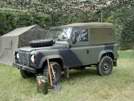
|
Land Rover 90. An example of the standard military Landrover in service from the mid eighties in 90 and 110 wheelbase versions. Powered by 4 cyl 2.5l diesel in both turbo and naturally aspirated version. Replaced the earlier Series 3 LWB and Lightweight and now being replaced in turn by the TUL(L) and TUL(M) Land Rover Defender XD (Wolf).
|

|
Landrover Lightweight. Originally developed in the late sixties to be air-portable with a narrower body and demountable panels to cut the weight down to the lifting capacity of the helicopters in service at the time. When it went into major production in the seventies these features were not required as capacities had increased, but it was adopted as the standard 1/2 tonne Landrover anyway. Served alongside the LWB Series 3 3/4 tonne Landrover until replaced by the 90/110. This example served in Germany. Had to be rebuilt on a new galvanised chassis after a group member piled it into a ditch at 40mph!
|
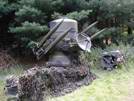
|
Rapier B1 Anti Aircraft Missile launcher. A demonstration model on loan to the group. Developed by British Aerospace for airfield defence and sold to numerous countries. The target is acquired by the radar in the main dome and then tracked by a separate optical tracker. The tracker operator fires the missile and guides it to the target. It has a range of 8 miles and is generally very effective. The Falklands highlighted some problems with tracking low flying aircraft in hilly country, and the "Pointing Stick Assembly Mk1" (I'm not joking!) was developed to assist the radar by eye (See picture elsewhere). The system is still in service with Australia and Switzerland, but has been replaced by Rapier FSC (Field Standard "C") in the UK which can track in all weathers.
|
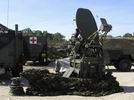
|
Blindfire Radar Tracker. Was developed to add 24 hour all weather capability to the B1 Rapier system. Built on same trailer chassis and uses same generator as the launcher so has same rapid deployment capability. Has since been further developed to form part of the latest Rapier FSC system. A former operator has told us that its introduction was unpopular as it meant the unit had to work round the clock instead of just daylight hours...
|
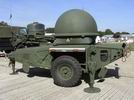
|
FSC Surveillance Radar. Part of the Rapier FSC system providing all round radar cover. Have powerful anti -jamming capabilities with multiple frequencies and enough power to burn through most jammers. The trailer chassis is an aluminium monocoque with a diesel powered generator pod at the rear and forms the base of all the elements of the FSC system towed by a 4 tonne truck. This particular trailer was a towing trials unit that was rolled and is an empty shell.
|
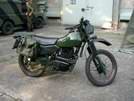
|
Armstrong Motor Cycle. Standard dispatch riders bike from the 1980s. Powered by 500cc Rotax single cylinder engine. Replaced in service by a similar Harley Davidson machine. Just make sure you don't scratch the paintwork!
|












